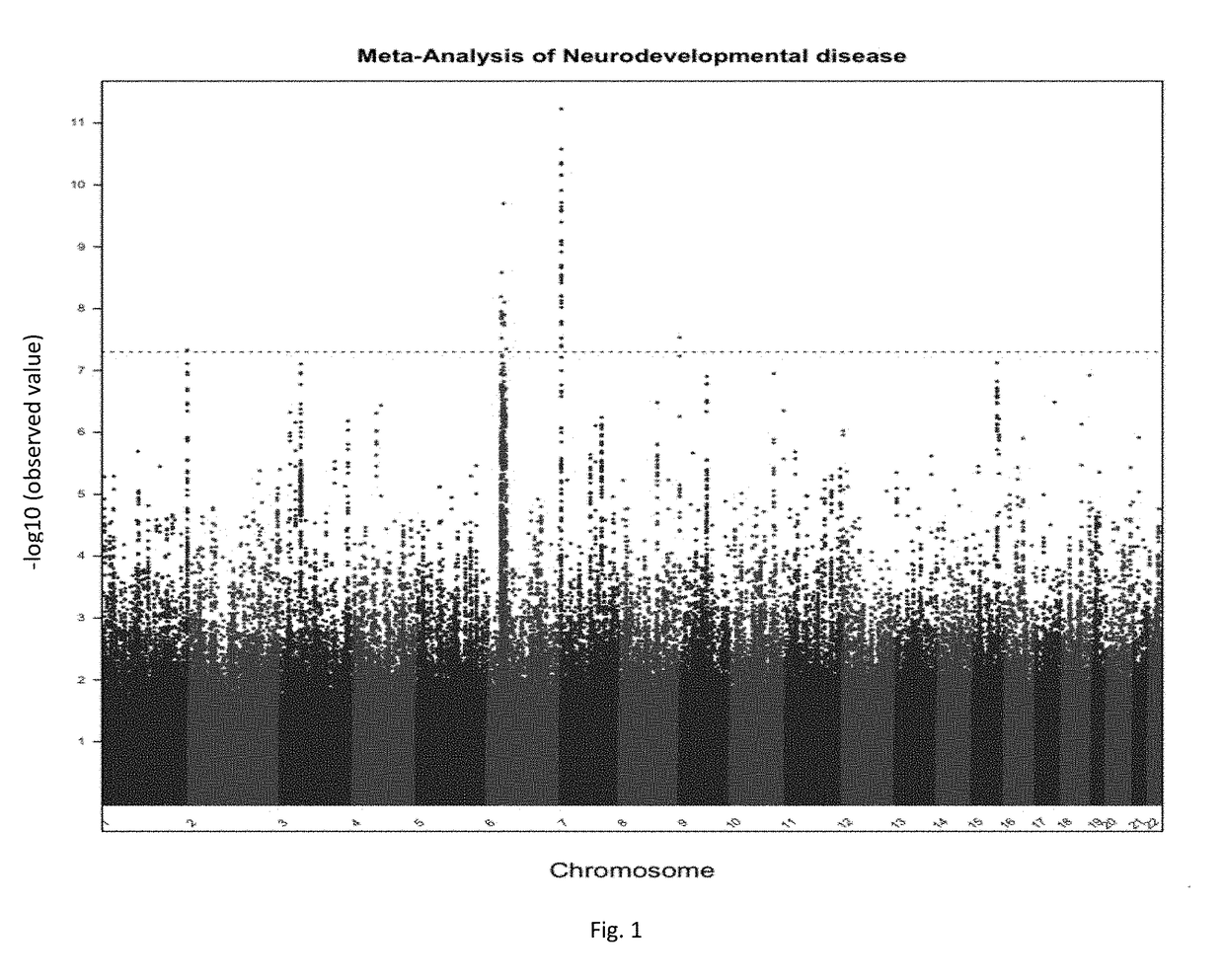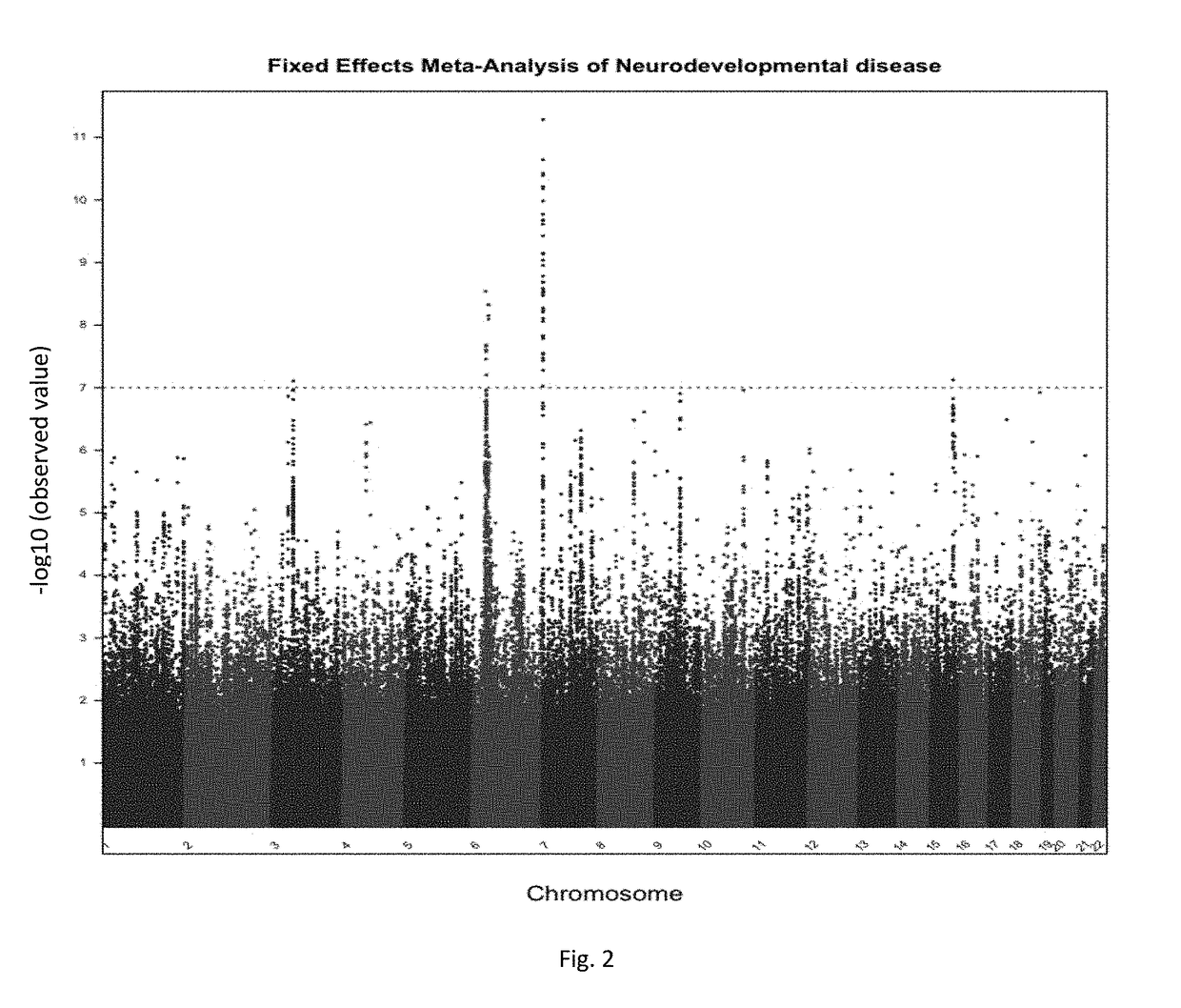Schizophrenia-associated genetic loci identified in genome wide association studies and methods of use thereof
a genetic locus and genome wide association technology, applied in the field of genetics and the diagnosis and treatment of schizophrenia, bipolar disorder and autism, can solve the problems of burden on their families and society, and achieve the effect of increasing the risk of schizophrenia
- Summary
- Abstract
- Description
- Claims
- Application Information
AI Technical Summary
Benefits of technology
Problems solved by technology
Method used
Image
Examples
example i
[0094]Schizophrenia is a neuropsychiatric disorder with world-wide prevalence of 1%, causing a huge social / economic burden. While the etiology of schizophrenia remains unknown, genetic factors play a key role as the disease is highly heritable. Here, we used genome-wide association (GWAS) approach to uncover variants that associate with schizophrenia, uncovering novel biological pathways that may lead to new treatments.
[0095]We have total of 18,069 schizophrenia, bipolar and autism samples together with 47,440 control samples, all with GWAS data and were meta-analyzed together. See the Manhattan plots shown in FIGS. 1 and 2. We identified several genome wide significant loci on chromosomes 15, 8, and 7.
Genome-wide Significant Loci
Chr15q25.2 neuromedin B—novel
[0096]Neuropeptide, associated with obesity and eating behavior.[0097]Association between SCZ and obesity reported by Kraepelin as early as 1919. 40-60% of SCZ population obese.
chr8q24.3 TSNARE1—novel[0098]SNARE domain containin...
example ii
[0107]A meta analysis of 13,394 schizophrenia and biploar cases and 34,676 controls, from 16 cohorts, was carried out to identify novel psychosis susceptibility loci. Following meta analysis, 40 variants at 6 loci surpassed genome wide significance. Five of the 6 loci have been associated with SCZ or BP. Two of the genome wide significant variants that mapped to one locus, TSNARE1, had not previously been shown to associate with either schizophrenia or bipolar disorder. The function of TSNARE1 is unclear, however, bio-informatic predictions based on phylogenetic ancestry indicate it may have a vertebrate specific function in intracellular protein transport and synaptic vesicle exocytosis.
Methods
[0108]Study Cohorts. The study included 13,394 schizophrenia and bipolar cases and 34,676 controls (Table 1) including 3,182 schizophrenia cases and 1,032 bipolar cases collected from 28 clinical trials conducted by Janssen Research & Development, LLC, these were matched to 15,277 and 8,000 c...
example iii
Protein—Protein Interactions (PPI) Show Association of Specific Gene Pathways with Schizophrenia and Bipolar Disorder
[0126]To test if any gene pathways are enriched in schizophrenia / BP we constructed a PPI network based on the results of the scz / BP GWAS meta-analysis including 13,394 cases and 34,676 controls (as previously described). Gene-level P-values were calculated from the meta-analysis data, 2,998 genes were significant with P-values below 0.05 from the 17,693 genes included in the analysis. The protein-protein interaction (PPI) network was constructed based on indices of protein interactions derived from primary interaction databases including BIND, BioGRID, CORUM, DIP, HPRD, InnateDB, IntAct, MatrixDB, MINT, MPact, MPIDB, MPPI and OPHID as compiled by iRefindex. The network algorithm was retrained using human-human protein interactions supported by at least two publications listed in Pubmed. The largest connected component (LCC, 540 nodes and 768 edges) was used for furthe...
PUM
| Property | Measurement | Unit |
|---|---|---|
| Tm | aaaaa | aaaaa |
| temperature | aaaaa | aaaaa |
| temperature | aaaaa | aaaaa |
Abstract
Description
Claims
Application Information
 Login to View More
Login to View More - R&D
- Intellectual Property
- Life Sciences
- Materials
- Tech Scout
- Unparalleled Data Quality
- Higher Quality Content
- 60% Fewer Hallucinations
Browse by: Latest US Patents, China's latest patents, Technical Efficacy Thesaurus, Application Domain, Technology Topic, Popular Technical Reports.
© 2025 PatSnap. All rights reserved.Legal|Privacy policy|Modern Slavery Act Transparency Statement|Sitemap|About US| Contact US: help@patsnap.com



